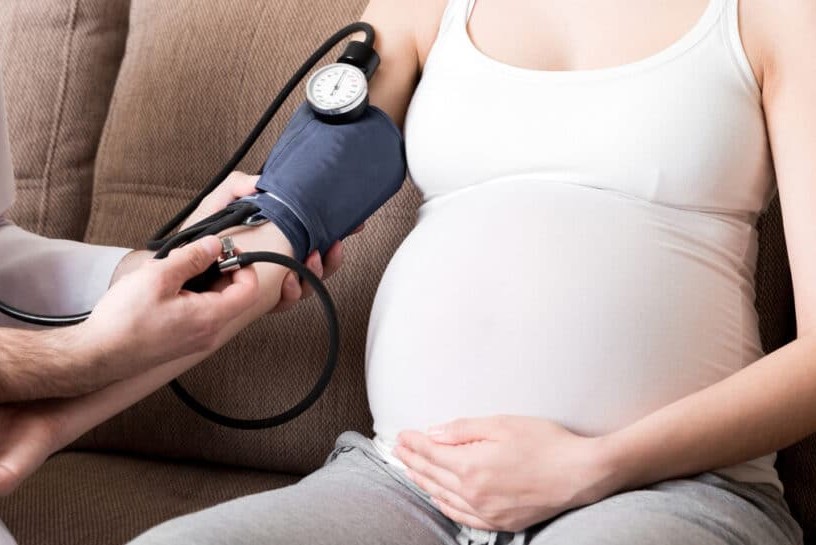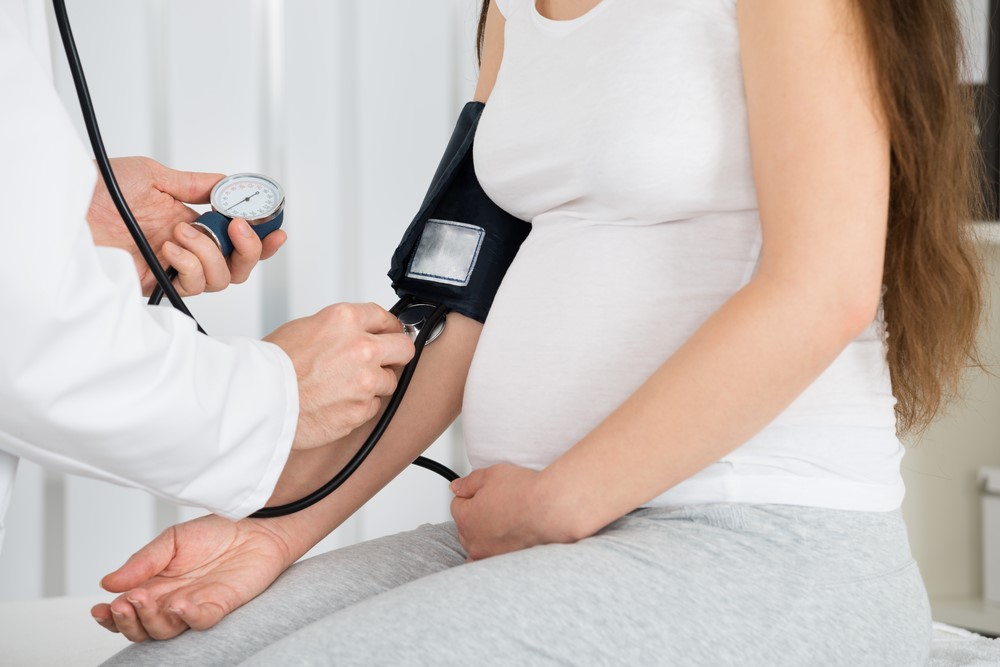
Pregnancy: A Blood Test Could Predict Early Preeclampsia Warning Signs, Study Says
Preeclampsia is a condition marked by high blood pressure combined with elevated levels of protein in the urine. It can lead to premature delivery, as well as other complications, ranging from kidney and liver problems in moms to low birthweights in babies
Preeclampsia typically occurs after 20 weeks into a pregnancy, but can also happen after a pregnancy.3
Warning Signs of Preeclampsia
- Vision changes, including blurriness or light sensitivity
- Persistent headaches
- Nausea, vomiting, or dizziness
- Pain in the upper right belly area
- Shoulder pain
- Rapid weight gain
- Swelling in the legs, hands, or face
- Difficulty breathing
With treatment, most pregnant people with preeclampsia deliver healthy babies
A new blood test could be the first to detect early warning signs for preeclampsia—a serious and sometimes deadly condition during pregnancy, according to a study by researchers at Stanford University.1
Experts behind the research suggest the test could be lifesaving, since many preeclampsia diagnoses are diagnosed late.
If verified and approved, the test could be the first to predict the future onset of preeclampsia early in pregnancy.
This would give doctors time to reduce a patient’s risk of developing the condition, which affects one in 25 pregnancies in the United States.2
“This is really shifting identification and the ability to intervene way to the left, way earlier in pregnancy,” Jonathan Cherry, the senior director of research operations at March of Dimes, an organization that supports advocacy, funding, and research around healthy pregnancies, told Verywell. March of Dimes contributed research to the Stanford study.
How Does An Early Detection Preeclampsia Test Work?
The Stanford researchers’ blood test examines a patient’s cell-free RNA (cfRNA) for the presence of 18 genes.
The more genes present in the test results, the greater the risk of preeclampsia.
Throughout a pregnancy, cfRNA levels can change in predictable ways that provide insight into the health of the fetus. By testing cfRNA levels in the blood, researchers can look for indicators of preeclampsia risk.4
“When you get preeclampsia, you have issues with your brain, your liver, your placenta, your child,” Cherry said.
“Cell-free RNA is one of these things that actually allows you to see further into what’s going on in multiple systems of the body through one isolate.”
The test can be administered as early as 5 weeks gestation and before symptoms occur.
If and when the test comes to doctors’ offices, the goal is for it to eventually become part of standard practice for all or most pregnant patients, Cherry said.
Why It Matters
Although most people with preeclampsia will have healthy babies, the condition does fall under the category of hypertensive disorders of pregnancy (HDP), which are the leading causes of death among pregnant people in the United States.3
Three out of five maternal deaths in the U.S. are considered preventable and are commonly associated with a missed or delayed diagnosis, according to the study researchers.1
Making a preeclampsia test part of the standard of care during early pregnancy could prevent diagnoses from being missed in the first place.
One of the reasons that preeclampsia diagnosis can be missed is because the disease presents differently in different people, and changes rapidly.
“It’s such a fascinating disease process, when you look at the pathophysiology of it, and also the presentation,” Jessica Shepherd, MD, a Texas-based OB-GYN and chief medical officer of Verywell Health, said on an Instagram live for Preeclampsia Awareness Month this week.
“Sometimes, someone walks in, I examine them, and I’m like, ‘you have preeclampsia.’ And then you have people who you would never know have it.’”
CHILD HEALTH: LEARN MORE ABOUT MEDICHILD BY VISITING THE BOOTH AT EMERGENCY EXPO
![]() Who Would Benefit From Early Testing Most?
Who Would Benefit From Early Testing Most?
According to the March of Dimes, high blood pressure, diabetes, kidney disease, autoimmune disease, and obesity place people at a higher risk for preeclampsia.
Family history, age, and previous pregnancy complications can play a role, too.3
Preeclampsia rates are about 60% higher in Black women than White women.
Black women are more likely to have severe cases of the disease, according to a 2020 report by The Preeclampsia Foundation.5
“If people in a high-risk group don’t get diagnosed early on, things get bad fast,” Cherry said.
How to Reduce Your Risk of Preeclampsia
Experts say low-dose aspirin, good nutrition, and exercise may reduce the risks of preeclampsia.67
Frequent check-ins with a doctor and understanding signs of preeclampsia are also crucial prevention measures,
Zsakeba Henderson, MD, senior vice president and deputy chief medical and health officer at March of Dimes said during the Instagram live.
“It’s so important for people to know what the warning signs and symptoms are,” Henderson said. “Sometimes, there are things that patients experience and they may think it’s just a normal side effect of pregnancy.”
For example, swollen hands are not normal, she said.
References:
- Moufarrej M, Vorperian S, Wong R, et al. Early prediction of preeclampsia in pregnancy with cell-free RNA. Nature. 2022;602(7898):689-694. doi:10.1038/s41586-022-04410-z
- Centers for Disease Control and Prevention. High blood pressure during pregnancy.
- March of Dimes. Preeclampsia.
- Moufarrej M, Wong R, Shaw G, Stevenson D, Quake S. Investigating pregnancy and its complications using circulating cell-free RNA in women’s blood during gestation. Front Pediatr. 2020;8. doi:10.3389/fped.2020.605219
- The Preeclampsia Foundation. Preeclampsia and racial and ethnic disparities.
- American Heart Association. Following a Mediterranean-style diet during pregnancy may reduce the risk of preeclampsia.
- Henderson JT, Vesco KK, Senger CA, Thomas RG, Redmond N. Aspirin use to prevent preeclampsia and related morbidity and mortality: Updated evidence report and systematic review for the US Preventive Services Task Force. JAMA. 2021;326(12):1192–1206. doi:10.1001/jama.2021.8551
Read Also:
Emergency Live Even More…Live: Download The New Free App Of Your Newspaper For IOS And Android
Blood Pressure: When Is It High And When Is It Normal?
Kids With Sleep Apnea Into Teen Years Could Develop High Blood Pressure
High Blood Pressure: What Are The Risks Of Hypertension And When Should Medication Be Used?
Pulmonary Ventilation In Ambulances: Increasing Patient Stay Times, Essential Excellence Responses
Thrombosis: Pulmonary Hypertension And Thrombophilia Are Risk Factors
Pulmonary Hypertension: What It Is And How To Treat It
Seasonal Depression Can Happen In Spring: Here’s Why And How To Cope
The Developmental Trajectories Of Paranoid Personality Disorder (PDD)
Intermittent Explosive Disorder (IED): What It Is And How To Treat It
Stress And Distress During Pregnancy: How To Protect Both Mother And Child
Assess Your Risk Of Secondary Hypertension: What Conditions Or Diseases Cause High Blood Pressure?



